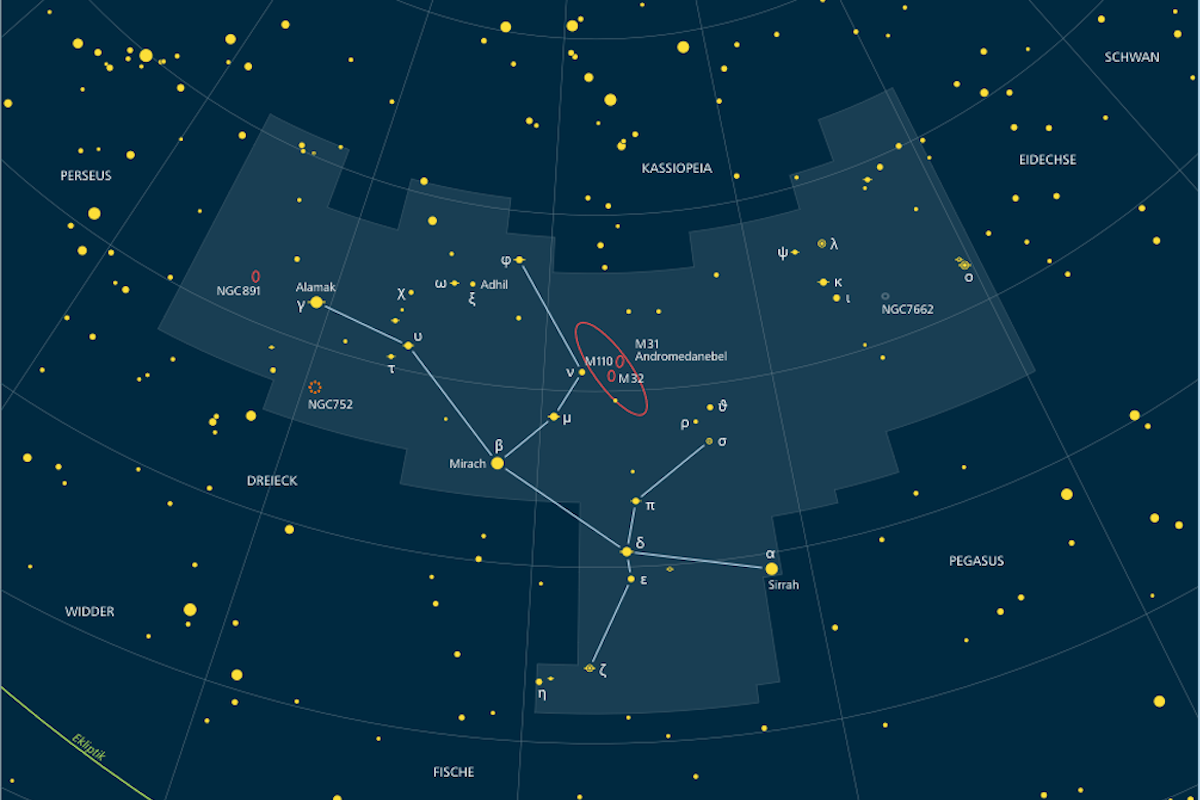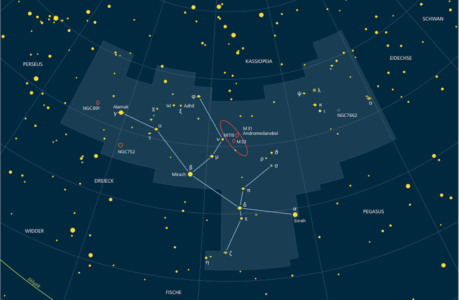Andromeda constellation, also known as Andromeda, is one of the most well-known and easily recognizable constellations in the night sky. It is named after the Greek mythological character Andromeda, the daughter of King Cepheus and Queen Cassiopeia. The constellation can be seen in the Northern Hemisphere during autumn and winter months and is visible from most parts of the world.
The brightest star in Andromeda is called Alpheratz, which also marks one of the corners of the Great Square of Pegasus. Other notable stars include Mirach, Alamak, and Adhil. Andromeda is also home to several deep-sky objects, including the Andromeda Galaxy, which is the closest spiral galaxy to our Milky Way and can be seen with the naked eye on a dark, clear night.
In Greek mythology, Andromeda was the daughter of a king who boasted about her beauty, comparing her to the sea nymphs. This angered the god Poseidon, who sent a sea monster to attack the kingdom. The king consulted an oracle, who advised him to sacrifice his daughter to appease the god. Andromeda was chained to a rock by the sea, but before the monster could attack her, the hero Perseus appeared and saved her. They fell in love and got married, and Andromeda was immortalized in the stars as a constellation.
For amateur astronomers and stargazers, Andromeda is a favorite constellation to observe. Its bright stars and deep-sky objects make it an ideal target for telescopes and binoculars. Andromeda is also visible from most places around the world, making it a universal sight that people from different cultures can appreciate and admire.
In conclusion, Andromeda constellation is a beautiful and beloved sight in the night sky. Its stars and deep-sky objects, combined with its rich mythology, make it a captivating subject for astronomers and stargazers alike. Whether you’re an experienced astronomer or just starting out, Andromeda is a constellation worth exploring and appreciating.
Finding the Andromeda constellation
Finding the Andromeda constellation in the night sky is relatively easy, and it is visible to the naked eye under the right conditions. The best time to look for Andromeda is during the autumn and winter months in the Northern Hemisphere when the constellation is high in the sky.
To locate Andromeda, look for the Great Square of Pegasus, which is another well-known constellation. The Great Square of Pegasus is a large square-shaped pattern of stars located near the horizon in the northeast direction in the early evening.
Once you have located the Great Square of Pegasus, look for a fainter, smaller constellation nearby that looks like a chain of stars. This is the Andromeda constellation, and it is located to the northeast of the square.
You can also use a star chart or an astronomy app on your phone to help you find Andromeda. These tools will show you the location of the constellation and can help you identify the stars and deep-sky objects within it.
Remember to find a dark location away from city lights, and let your eyes adjust to the darkness for at least 15 minutes. With some patience and a little bit of luck, you should be able to spot the Andromeda constellation in all its cosmic beauty.
The stars of the Andromeda constellation
The Andromeda constellation is home to several notable stars, each with their own unique properties and characteristics. The brightest star in the constellation, Alpheratz, is actually shared with the neighboring Pegasus constellation and marks one of the corners of the Great Square of Pegasus. Alpheratz is a spectral type B8IV star, which means it is a blue-white subgiant star that is hotter and brighter than the Sun.
Another notable star in the Andromeda constellation is Mirach, which is a red giant star located in the middle of the constellation. Mirach is an M-class star, which means it is much cooler than the Sun and has a reddish-orange hue. Despite being relatively dim, Mirach is visible to the naked eye and is often used as a guide to find the Andromeda Galaxy.
Alamak, also known as Gamma Andromedae, is a binary star system located in the Andromeda constellation. It consists of two stars that orbit around each other, with the primary star being a spectral type K5III star and the secondary star being a spectral type B9IV star. Alamak is visible to the naked eye and appears as a single point of light, but it can be resolved into two separate stars with a small telescope.
Adhil, also known as Xi Andromedae, is a double star system located in the Andromeda constellation. It consists of two stars that are close together and appear as a single point of light to the naked eye. The primary star is a spectral type F5V star, while the secondary star is a spectral type K1V star.
Delta Andromedae is another double star system located in the northern part of the constellation. It consists of two stars that orbit around each other and can be seen with a small telescope. The primary star is a spectral type B8V star, while the secondary star is a spectral type A3V star.
These stars, along with several other fainter ones, make up the beautiful Andromeda constellation. Stargazers and astronomers alike enjoy observing and studying these stars to better understand the properties and nature of the cosmos.
Deep sky objects in the Andromeda constellation
The Andromeda constellation is not only known for its beautiful stars but also for its deep-sky objects, which include galaxies, nebulae, and star clusters. Here are some of the most notable deep-sky objects in Andromeda:
- Andromeda Galaxy (M31) – The Andromeda Galaxy is a spiral galaxy and the largest member of the Local Group, which includes the Milky Way and several other galaxies. It is the closest galaxy to our own and can be seen with the naked eye on a dark, clear night. The Andromeda Galaxy is also a popular target for astrophotographers and astronomers.
- Andromeda II (M31b) – Andromeda II is a dwarf spheroidal galaxy that is a satellite of the Andromeda Galaxy. It is located about 2.22 million light-years away and is one of the closest dwarf galaxies to our own.
- NGC 891 – NGC 891 is a beautiful edge-on spiral galaxy that is located about 30 million light-years away from Earth. It is known for its prominent dust lane that runs along its disk.
- NGC 7662 (Blue Snowball Nebula) – NGC 7662 is a planetary nebula located in the Andromeda constellation. It is named after its blue-green color and spherical shape.
- M32 – M32 is a dwarf elliptical galaxy that is a satellite of the Andromeda Galaxy. It is located about 2.65 million light-years away and is one of the brightest dwarf galaxies in the Local Group.
- NGC 752 – NGC 752 is an open star cluster located in the Andromeda constellation. It is about 1.3 billion years old and contains over 60 stars.
These deep-sky objects, along with several others in the Andromeda constellation, make it a popular target for amateur and professional astronomers alike. Whether observing with a telescope or just enjoying the beauty of the night sky, the Andromeda constellation is truly a cosmic wonder to behold.

